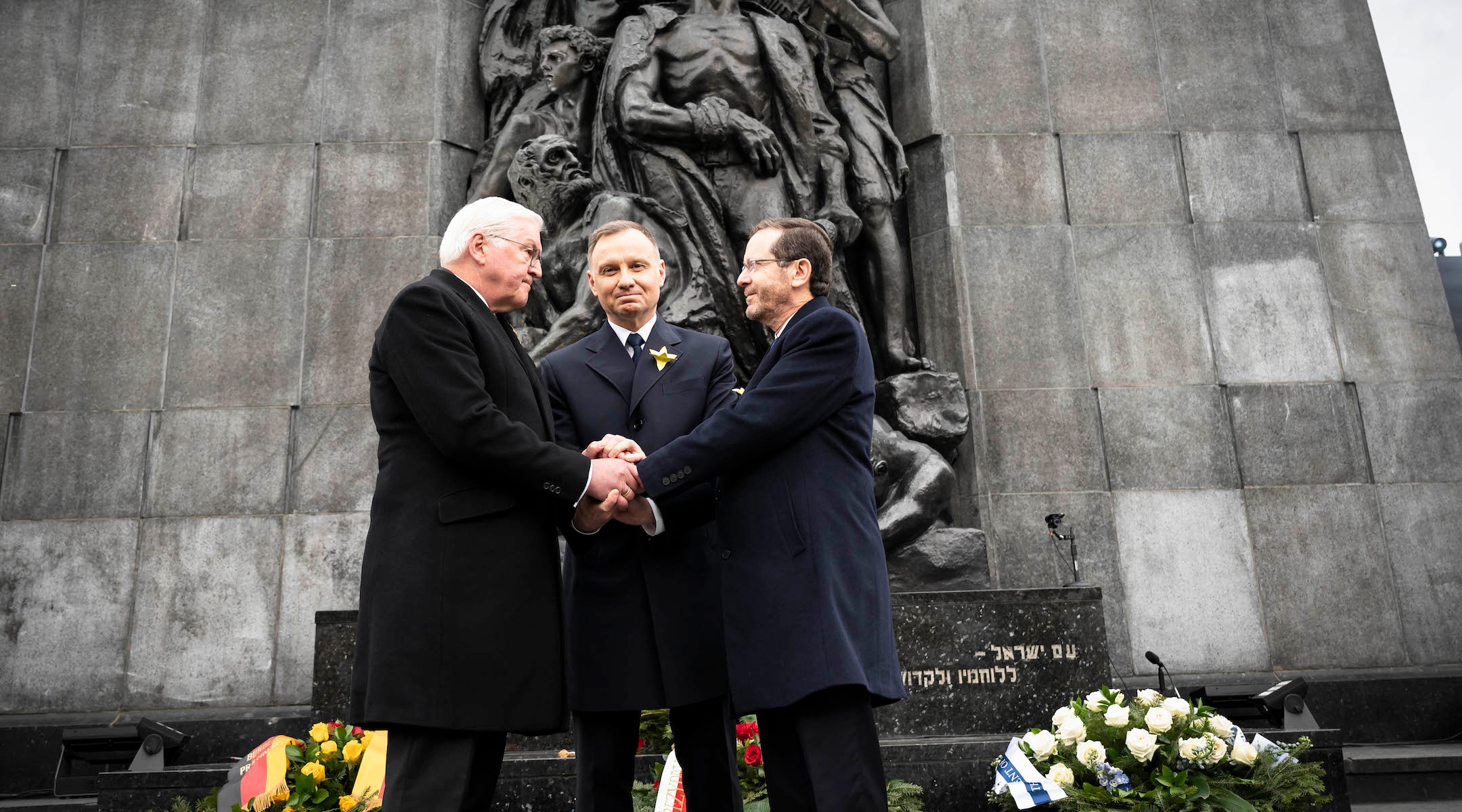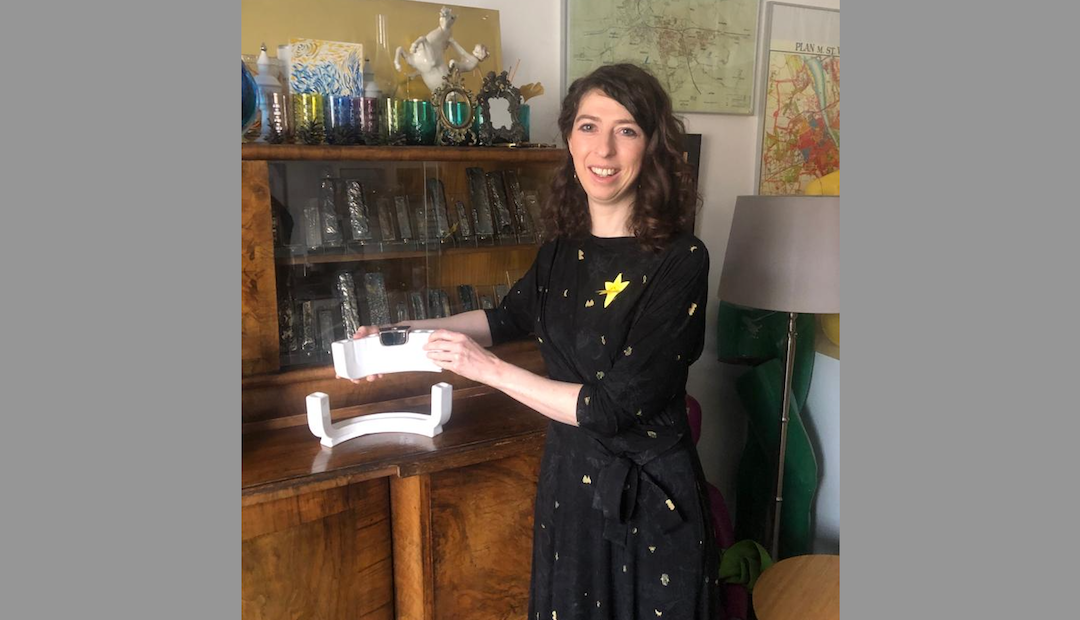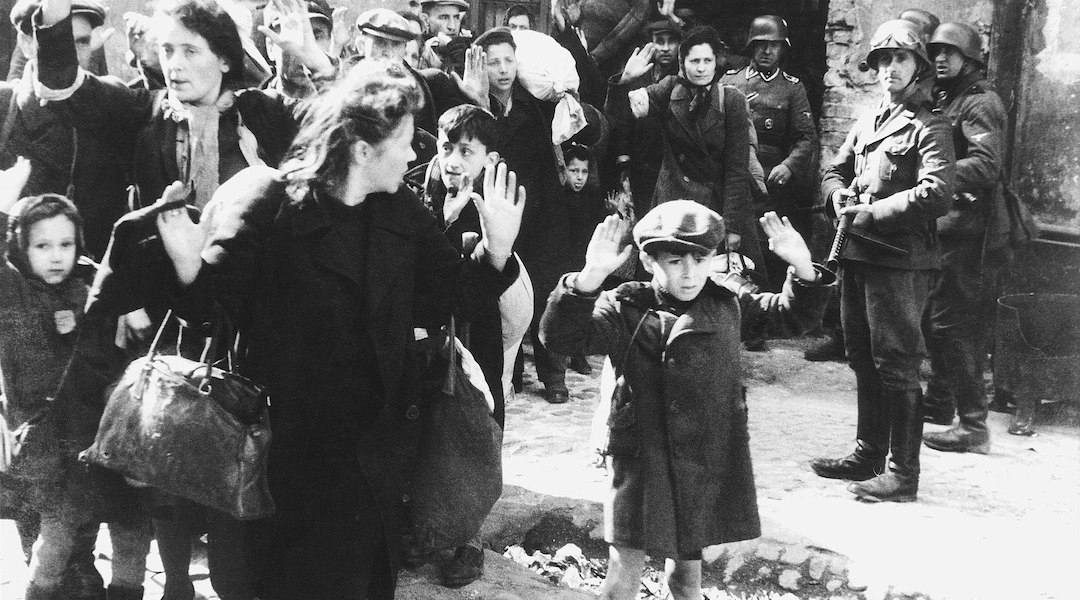Warsaw Ghetto Uprising’s 80th anniversary remembered with daffodils, 3 presidents and an 11th commandment against ‘indifference’
For the first time, the presidents of Germany, Israel and Poland came together for a ceremony to commemorate the fighters, none of whom are alive today

A few hundred politicians, Jewish leaders and others marked the 80th anniversary of the Warsaw Ghetto Uprising at the Ghetto Heroes Monument in Warsaw, April 19, 2023. (Artur Widak/Anadolu Agency via Getty Images)
WARSAW (JTA) — Exactly 80 years ago, a few hundred ragtag, half-starved Jews emerged from sewers in Warsaw to battle Nazis – and held them off for nearly a month rather than surrender themselves and their Jewish brethren to the Treblinka and Majdanek death camps.
On Wednesday, thousands of Poles and international visitors, including Polish President Andrzej Duda, Israeli President Issac Herzog and German President Frank-Walter Steinmeier, marked the 80th anniversary of the Warsaw Ghetto Uprising in a stirring Holocaust commemoration festooned with daffodils, the emergent symbol of the largest Jewish rebellion against the Nazis during World War II.
“As German federal president, I stand before you today and bow to the courageous fighters in the Warsaw Ghetto,” Steinmeier told a few hundred politicians, Jewish leaders and others at the Ghetto Heroes Monument, marking the first time a German president has joined in the annual commemoration. “I stand before you today and ask for your forgiveness for the crimes committed here by Germans.”
This was also the first time leaders from all three countries came together for the official uprising ceremony to commemorate the fighters, none of whom are alive today. The last surviving fighter, Simcha Rathajzer-Rotem, also known as Kazik, died in December 2018. A handful of Warsaw Ghetto survivors who were not old enough to join the fighting remain, according to Holocaust scholars.
In another first, the three heads of state attended a commemorative service led by Poland’s Chief Rabbi Michael Schdurich at Warsaw’s Nozyk Synagogue. By the end of the ceremony, which was conducted mostly in Hebrew and featured Polish-Jewish children singing the Polish and Israeli national anthems, many attendees had tears in their eyes.
“I just thought, the leaders are here, this is something we should do, it’s part of building relationships and collective memory that partnerships are built on,” Schudrich told the Jewish Telegraphic Agency.
Earlier in the day, Polish President Duda called the fighters “the heroes of the Jews all over the world” and “the heroes of Poland and the Poles.”
Herzog, a day after Yom Hashoah, Israel’s Holocaust Remembrance Day, praised the fighters for sparking hope during one of humanity’s most tragic times. “In a world falling apart, in the shadow of death, under conditions of humiliation, famine, and forced labor, in the ghettos… they succeeded — mothers, fathers, children, grandfathers, and grandmothers — in upholding human morality, mutual responsibility, faith and basic humanity,” he said.

Wednesday’s diplomatic tribute, which also included speeches by World Jewish Congress President Ronald Lauder and Marian Turski, a Lodz Ghetto survivor whose so-called 11th commandment — “Thou shalt not be indifferent” — became the slogan for programming by the POLIN Museum of the History of Polish Jews around the commemoration.
Eleven years ago, POLIN commissioned Jewish artist Helena Czernek to design a simple paper flower daffodil that has since been worn on the uprising’s anniversary to raise awareness of the day. The pin design was inspired by a commander of the uprising, Marek Edelman, who died in 2009. Each year he would receive a bouquet of daffodils to mark the anniversary date from an anonymous sender, and he would in turn place them on the city’s Monument to the Ghetto Heroes — a large sculpture standing at the site of the uprising’s first battle.
The daffodil marker has since changed the landscape of Holocaust memory in Poland, according to POLIN museum spokeswoman Marta Dziewulska.
“Our research shows that since we began our educational programs around this event, including handing out the daffodils, the rise in general public knowledge about the uprising has been enormous,” said Dziewulska.
This year, thanks in part to financial support from Lauder, a billionaire heir to the Estee Lauder fortune and a major Republican donor, the daffodil campaign reached far more people than ever, both in Poland and beyond. Throughout the center of Warsaw, the paper daffodil was ubiquitous among pedestrians and cafe dwellers across generations. All crew members on LOT Polish airline flights wore them.
For the first time, the daffodils were also distributed to 150,000 people in 100 Jewish communities around the world. More than 3,000 volunteers gave out 450,000 paper daffodils in six cities across Poland, and over 7,000 schools, libraries and cultural institutions participated in the museum’s daffodil campaign, which includes films and educational materials about the uprising.

Krystyna Budnicka, who was 11 at the time of the uprising, told journalists about her story on Monday. The fighters of the Jewish Combat Organization (ŻOB) were armed with home-made grenades and Molotov cocktails. In the end, roughly 13,000 Jews were were burnt alive or suffocated as the Nazis burnt down the ghetto to quell the rebellion, sending the remaining some 50,000 Jews to be murdered further east.
Budnicka told the Polish newspaper Gazeta Wyborcza that “as the ghetto was burning, the underground was like a bread oven.”
But Budnicka and some of her 10 immediate family members, none of whom survived the Holocaust, had one advantage. Her brothers and father were observant Jews who happened to be carpenters. They had constructed a bunker to lead to the sewers so that eventually, at least she and her brother, who later died of typhus, were able to make it out.
Budnicka was later taken in by a Catholic orphanage while the war was still raging and hid her Jewish identity, changing her last name from Kuczer to Budnicka. Until the 1990s, she told almost no one of her travels. But today she is the ambassador of POLIN Museum.
Her recollection of life at the time is limited, except that she had hope for survival. The fighters slept during the day in bunkers the Nazis couldn’t easily find, and came out of the sewers to fight at night. She remembers hunger, being the only girl among many boys and dreaming about what bread tasted like, a distant memory.
Many decades later, after the end of the Communist dictatorship, a “Children of the Holocaust” association was formed in Poland. For the first time, Budnicka and many others started telling their stories out loud, and at schools.
“Now I feel that I have to do it,” she told Gazeta Wyborcza. “When I mention my loved ones at meetings, it’s like I’m erecting a monument to my family. They live then. I see them. It’s in order: my mother Cyrla, father Josef Lejzor, brothers Izaak, Boruch, Szaja, Chaim, Rafał.”
Budnicka is not the only Warsaw Ghetto survivor to ask the world to remember what she endured. Helena Birnbaum, 93, who also survived by hiding in a bunker, participated in this year’s March of the Living — an annual Holocaust remembrance event that brings thousands of participants from around the world to Auschwitz-Birkenau. She told reporters at the march on Tuesday why she flew all the way to Poland from Israel to talk about her ordeal.
“The importance of knowing about the Holocaust is to know the person in all situations, on the brink of death,” she said. “The importance of knowing that the Holocaust was life within death and not everyone died at once. The individual stories matter.”

The act of international unity in display at the official uprising ceremony comes at a time when Poland’s right-wing government continues to espouse a nationalist narrative that international scholars say downplays Polish antisemitism and violence towards Jews before, during and after World War II. Multiple Polish laws connected to Holocaust rhetoric and restitution payments caused diplomatic tensions between Poland and Israel for years, and the two only resumed more full relations last month. The rapprochement came after Israel’s foreign minister announced the resumption of Israeli student trips to Holocaust sites in Poland, which now could include sites that explain Nazi violence against non-Jewish Poles.
Six years ago, some Polish Jews who rejected their government’s patriotic narrative launched their own uprising commemoration, which has grown from a group of hundreds to nearly a thousand. During the alternative commemoration on Wednesday, which featured Yiddish songs sung by school children and recitations of poetry by Polish-Jewish authors, participants laid paper and real daffodils at Warsaw Ghetto monuments such as Umschlagplatz, where the Nazis deportee 350,000 Jews by train to Treblinka.
Patrycja Dolowy, director of Warsaw’s Jewish community center, was an early supporter of what she called a grassroots alternative to the pomp and circumstance of the government’s ceremony, only a few hundred feet away.
“Jews were sentenced to death in the center of their own city and the majority of people outside the ghetto were doing nothing about this,” said Dolowy, who believes government focus on heroism should not erase inquiry into less heroic actions by Poles.
“If Jews were not treated before the war as strangers, it would have been much easier for everyone, Jews and non-Jews, to rise together and resist,” she theorized.
The counter-commemoration reflects the contrasting attitudes in Poland towards honoring Jewish and Holocaust memory. In 2017, the government passed a law that assured public schools taught history from a heroic, patriotic perspective, and in 2018 made it illegal to insult the Polish nation’s Holocaust record, condemning scholars who dared delve into historical Polish aggression against Jews.

Jerzy Warman, 76, a Polish-born Jew participating in the non-governmental commemoration whose parents survived the Warsaw Ghetto, said the Polish government wants to turn the uprising commemoration into an event where “they can do a roll call of Poles who they say helped the Jews.”
Warman noted that his father joined Edelman at the Warsaw Uprising, a major Polish resistance campaign that took place year after the Ghetto Uprising. “The Jews tried to join the Polish Home Army as a group but were rejected by them,” Warman recalled his father explaining.
Moshe Kis, 22, a Jewish political science student from Warsaw whose grandmother spent two years in the ghetto, echoed Warman’s view.
“So many people here still don’t understand their own history,” said Kis, who will immigrate to Israel next year. He added, fiddling with a daffodil over coffee, “when the sirens went off today in honor of the uprising, I heard people around me saying on the street, ‘what is this for, are we being invaded?’”
This article originally appeared on JTA.org.
Correction: An earlier version of this story misreported how Krystyna Budnicka changed her name. She changed it from Kuczer to Budnicka, not the other way around.
A message from our Publisher & CEO Rachel Fishman Feddersen

I hope you appreciated this article. Before you go, I’d like to ask you to please support the Forward’s award-winning, nonprofit journalism so that we can be prepared for whatever news 2025 brings.
At a time when other newsrooms are closing or cutting back, the Forward has removed its paywall and invested additional resources to report on the ground from Israel and around the U.S. on the impact of the war, rising antisemitism and polarized discourse.
Readers like you make it all possible. Support our work by becoming a Forward Member and connect with our journalism and your community.
— Rachel Fishman Feddersen, Publisher and CEO






















